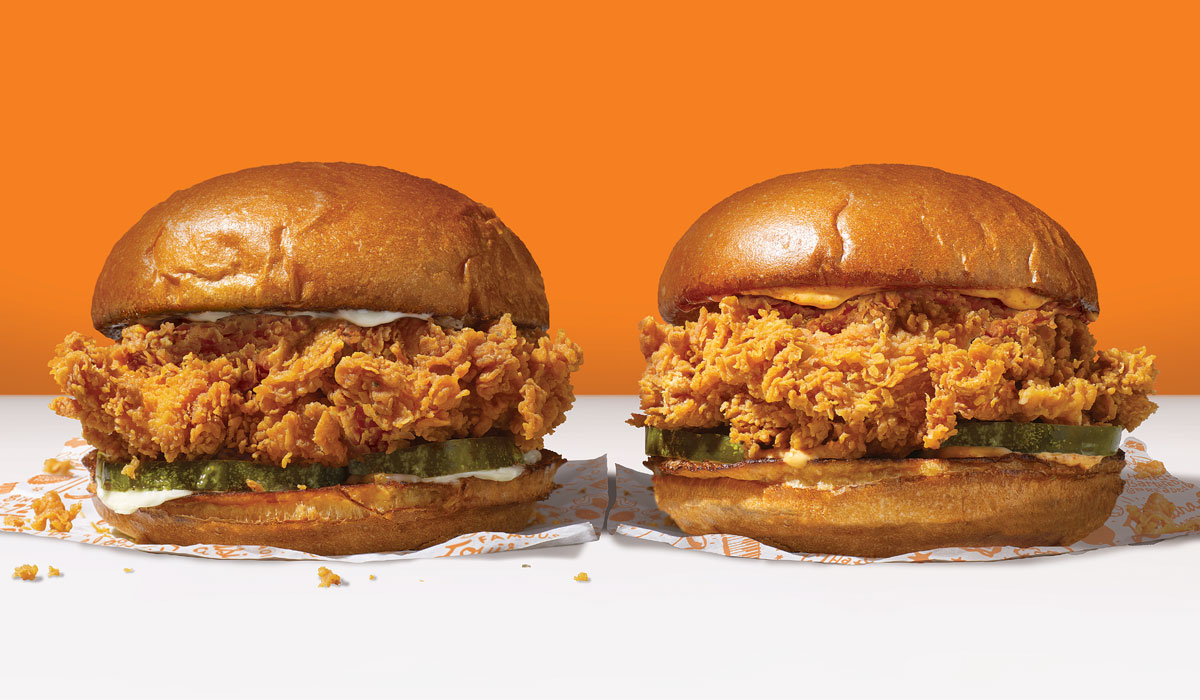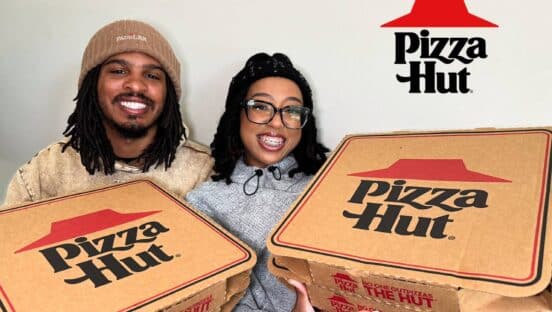Whether or not there’s attrition with the phrase “chicken sandwich wars” or not, there’s zero evidence consumers are tiring of the product itself. According to ecommerce data company Edison Trends, overall spending on chicken sandwiches grew 420 percent between January 2019 and December 2020.
It measured more than 100,000 U.S. food delivery app transactions from Chick-fil-A, Popeyes, McDonald’s, Wendy’s, Burger King, Jack in the Box, Zaxby’s, and KFC.
As of December, Chick-fil-A led in market share (45 percent), followed by Popeyes (17 percent), McDonald’s (16 percent), and Wendy’s (7 percent). Further proving the power of Popeyes’ category-changing launch, it briefly took the lead from Chick-fil-A in January 2020—a remarkable feat when you consider it.
READ MORE: Thanks to Chicken Sandwich, Popeyes is Making $400K More Per Restaurant
Popeyes delivered systemwide sales growth of 32 percent in Q1 of 2020, the three-month period that ended March 31 and covered that timeframe. And that was with a COVID-19 bottom-out thrown in. Still, it goes to show how lofty the product’s peak was reaching.
[image source_ID=”129228″]
You can see above how Popeyes grabbed share when its chicken sandwich arrived in August 2019. After selling out, it recovered by November, climbing to the apex in January, when it seized 33 percent of the online delivery spend, for chicken sandwiches, between these brands.
After that, Chick-fil-A regained the top spot and has held since, with 45 percent of share in December, up 2 percentage points over November.
Revenue Management Solutions released the first half of a two-part survey intended to assess consumers’ awareness of, and craving for, chicken sandwiches among top brands. This past week, it asked 1,020 quick-service restaurant users (those who have visited a counter-service brand in the past three months) how they felt about the state of things. RMS will do so again after high-profile rollouts from McDonald’s and KFC. Burger King is also on deck for some time in 2021.
RMS’s data examined February 5 to February 14.
Some key findings:
Nationally, Chick-fil-A remains the awareness leader. When asked to recall brands that offer chicken sandwiches and report on sandwiches they crave most, respondents overwhelming chose Chick-fil-A. “Despite having a much smaller footprint than other [quick-service restaurants],” RMS said.
[image source_ID=”129229″]
Worth noting, Chick-fil-A has never really struggled to out-punch its weight class in terms of unit count versus brand value, and sales for that matter. Some argue it’s actually one of Chick-fil-A’s anchor points, much like In-N-Out Burger, yet on a larger scale (2,500 locations compared to 354). Regional and cult-like perception that drives pent-up demand, market-to-market. “We’re in California, we need to visit In-N-Out.” Perhaps that’s also one reason being closed on Sundays doesn’t hurt Chick-fil-A all that much, either.
In 2019, Chick-fil-A was one of only six restaurant brands to eclipse $10 billion in domestic sales. But it had far and away the fewest locations. In fact, in all of quick service, Chick-fil-A is just the 19th largest brand on the map.
And here’s how it stacked up by total systemwide sales year-end 2019: McDonald’s ($40.4 billion); Starbucks ($21.5 billion); Chick-fil-A (11 billion); Taco Bell ($11 billion); Burger King ($10.3 billion); and Subway ($10 billion). Again, with six days of service each week versus seven. It makes up the gap with an industry-leading average-unit volume of $4.517 million.
In terms of U.S. unit count—Subway (23,802); Starbucks (15,041); McDonald’s (13,846); Burger King (7,346); Taco Bell (7,089); and Chick-fil-A (2,500).
So there’s no real surprise to see Chick-fil-A’s performance bleed into chicken sandwich prominence. It’s no secret among competitors. Really, it’s why Popeyes went after Chick-fil-A on Twitter to kick off its sandwich campaign.
When looking at results for respondents based in suburban locations, Popeyes overtook McDonald’s as the second-most craved brand. In rural markets, Chick-fil-A was followed by McDonald’s, Wendy’s, and KFC.
Speaking to broader trends, consumers reported spending less on a chicken sandwich meal than a beef burger one. Three in five said they forked up less than $5.99 on a chicken sandwich offering, while only one in two spent the same on a beef burger meal.
More than 70 percent said they believe a chicken sandwich should be priced lower than a beef burger.
Meanwhile, only 51 percent said they buy chicken as a more affordable option.
And lastly, 46 percent believe chicken is better value than beef.
[image source_ID=”129230″]
This suggests brands should tread lightly in pricing when entering or engaging in the chicken sandwich wars. While clearly in demand, it’s still not seen as quite the indulgent experience beef is.
Gen Z presented the highest percentage of respondents self-reporting they were spending more on quick service when compared to pre-COVID times. One explanation, RMS said, could be they’re visiting fewer casual-dining restaurants and counter service is filling the void.
Fifty-seven percent of Gen Z reported spending more on food when visiting a quick-service restaurant—higher than any other age group: millennials (46 percent), Gen Z (38 percent), Boomers (31 percent).
To dive deeper into the chicken sandwich craze and where we go from here, QSR chatted with Matt Voda, CEO of OptiMine and a nationally recognized expert in marketing strategy. He’s advised brands from Bed Bath & Beyond to American Girl in the past.
Will the battle fizzle out? Will it take off even more? Why was Popeyes so successful? Let’s jump in.
Chicken sandwiches appear on 47.8 percent of total U.S. restaurant menus—why is this menu option so big right now and why is marketing at the forefront of this trend?
This menu option has followed the overall chicken consumption growth in the US- or perhaps, it is one of the reasons that chicken is the most-consumed meat in the US. Either way, Americans consume more chicken than any other meat, surpassing beef, pork, and fish. See USDA chart here.
There may be many reasons for the overall chicken consumption growth and the large presence on restaurant menus: a perception that chicken is a healthier protein choice, fear over red meat consumption, costs, or perhaps that for many Americans, it tastes good.
From a marketing perspective, there are likely several objectives at play. First, awareness is a primary driver. If you are a restaurateur, and you believe you have a superior chicken sandwich, you want as many people to know about it, and ultimately to convince them to try it. If we were using a sports analogy, we’d consider this “going on offense.” Now, if you’re late to the game, and you could put McDonald’s in this category strange as that sounds, you are now required to play catchup AND defense at the same time. The second marketing driver is to protect and defend your core business, especially if you are worried that other chains have gained chicken sandwich momentum and are draining customers and market share away from your brand. This probably explains why the Golden Arches moved so quickly to try another formulation of chicken.
Chicken sandwiches are soaring thanks to the success of Popeyes version—what sort of marketing initiatives have made the menu option so successful for them?
At OptiMine, one of our marketing measurement goals is to identify the non-marketing factors driving the business. While initially counterintuitive, this approach actually makes it clearer how much marketing and advertising is contributing versus all other factors. In many cases, the non-marketing factors drive a larger share sales variance. Why does this matter? Well, in the case of restaurants, you cannot ignore the role of the actual food in the sales picture. Popeyes chicken sandwich was a winner, because the sandwich is great. If Popeyes’ chicken sandwich was not great when they launched it in 2019, there’s no amount of marketing that would have fixed that fundamental and fatal flaw.
Starting with a great menu item in 2019, Popeyes was then able to leverage marketing, and in particular, social media, to spread this good news, positive reviews and convince new customers to try the sandwich. It didn’t hurt that they began to run out of the sandwiches as this perpetuated the mythical sandwiches’ status. If you can’t have something, you want it more- especially when your friends and family are posting about it on social media.
[image source_ID=”129192″]
McDonald’s is also doubling down on its chicken options, launching three new chicken sandwiches—what marketing tactics must be used in order to gain more momentum versus its competitors?
McDonald’s is taking a page out of the same “exclusivity” playbook with its own CHKNDrop campaign, selling early, exclusive access to try their new sandwiches as if they were limited edition Nike sneakers. The fact that we are talking about this campaign means it is working as it gathers earned coverage from a PR and social standpoint.
Again, the goal for McDonalds here is twofold: generate awareness and product trials; and protect their core business from the Popeyes of the world. But they better hope they have a winner of a sandwich because marketing can only do so much with a poor product.
Taco Bell isn’t known for their chicken, at least in sandwich form, unlike some of its competitors—how can marketing help the chain reach their loyal customers and also those who wouldn’t typically choose Taco Bell? (there is a chicken sandwich taco coming …)
In many ways, Taco Bell’s challenge is even greater than McDonalds’ but there may be more upside if they succeed. When customers make a run for the border, they aren’t sprinting for the chicken. Taco Bell hasn’t had many chicken items on their menu historically so they have a bigger hurdle to overcome to attract a core group of chicken-loving consumers who never went to Taco Bell for this reason. But, if Taco Bell is able to convince the adventurous to give them a shot- and they like the chicken chalupa (or whatever they name the new creation), they stand a chance to get that same new customer to try their other offerings with the hope that they turn them into regulars.
Taco Bell could also target customers who are tired of the same chicken/mayo/pickle/bun combination and are looking for something new. Expect their marketing to play up their differences with the rest of the fast food universe, while making advertising appeals for consumers to try something on the wilder side of the boring chicken landscape. In this way, their marketing will work to set them apart, while simultaneously convincing consumers to try their offering.
Who’s best positioned to win the chicken sandwich wars and why?
A rising tide lifts all boats. If the entire chicken category continues to grow, all of the players stand to do better, or at least maintain market share as consumers switch away from beef toward chicken. And of course, those with a superior product stand to “win more.”
Matt Voda is the CEO at OptiMine Software, a cloud-based cross-channel marketing analytics and optimisation company. He joined the company from United Health Group, where he led consumer marketing and analytics within the $40 billion Optum division. Voda also spent 11 years at Digital River as vice president of product management, helping develop the world’s first cloud-based e-commerce platform.






